少儿英语赛课教案
少儿英语公开课教案lesson
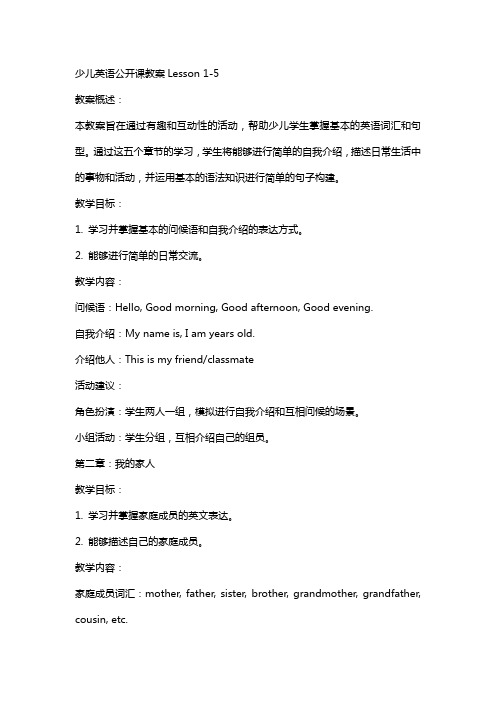
少儿英语公开课教案Lesson 1-5教案概述:本教案旨在通过有趣和互动性的活动,帮助少儿学生掌握基本的英语词汇和句型。
通过这五个章节的学习,学生将能够进行简单的自我介绍,描述日常生活中的事物和活动,并运用基本的语法知识进行简单的句子构建。
教学目标:1. 学习并掌握基本的问候语和自我介绍的表达方式。
2. 能够进行简单的日常交流。
教学内容:问候语:Hello, Good morning, Good afternoon, Good evening.自我介绍:My name is, I am years old.介绍他人:This is my friend/classmate活动建议:角色扮演:学生两人一组,模拟进行自我介绍和互相问候的场景。
小组活动:学生分组,互相介绍自己的组员。
第二章:我的家人教学目标:1. 学习并掌握家庭成员的英文表达。
2. 能够描述自己的家庭成员。
教学内容:家庭成员词汇:mother, father, sister, brother, grandmother, grandfather, cousin, etc.描述家庭成员的句子:My mother is a teacher. My father likes playing football.活动建议:图片匹配:展示家庭成员的图片,学生将图片与正确的英文词汇配对。
故事创作:学生用所学的家庭成员词汇编一个小故事。
第三章:我的学校教学目标:1. 学习并掌握学校相关词汇。
2. 能够描述自己的学校。
教学内容:学校场所词汇:classroom, library, playground, office, etc.描述学校的句子:I go to school bus. My favorite subject is math.活动建议:图片排序:展示学校的图片,学生将图片按照正确的顺序排列。
小组讨论:学生分组,讨论并介绍自己学校的特点。
第四章:我的兴趣爱好教学目标:2. 能够描述自己的兴趣爱好。
赛课小学英语教案模板

课时:1课时年级:四年级教材:《人教版小学英语》四年级上册教学目标:1. 让学生掌握本节课的单词和句型,提高学生的英语口语表达能力。
2. 培养学生的合作意识,提高学生的团队协作能力。
3. 培养学生的创新思维,提高学生的综合素质。
教学重点:1. 单词:cat, dog, fish, bird, car2. 句型:What's this? It's a .../This is a .../What are these? They are ...教学难点:1. 学生能够熟练运用句型进行对话。
2. 学生能够在活动中运用所学单词和句型。
教学准备:1. 多媒体课件2. 英文卡片3. 游戏道具教学过程:一、导入1. 老师出示一张动物图片,引导学生说出动物的英文名称。
2. 学生自由练习,教师巡视指导。
二、新授1. 老师出示单词卡片,带领学生认读单词。
2. 学生跟读单词,教师纠正发音。
3. 老师出示句型卡片,引导学生说出句型。
4. 学生跟读句型,教师纠正发音。
5. 老师带领学生进行句型练习,如:What's this? It's a cat./This is adog./What are these? They are birds./These are cars.三、巩固1. 游戏环节:分组进行“单词接龙”游戏,每组轮流说出一个单词,下一个学生必须说出一个以前说过的单词,以此类推。
2. 对话练习:学生两人一组,运用所学单词和句型进行对话。
四、拓展1. 老师出示一张交通工具图片,引导学生说出交通工具的英文名称。
2. 学生自由练习,教师巡视指导。
五、总结1. 老师带领学生回顾本节课所学内容。
2. 学生分享自己在课堂上的收获。
六、作业1. 学生回家后,用所学单词和句型编一个小故事,与家长分享。
2. 学生准备下一节课的展示内容。
教学反思:本节课通过多种教学手段,如游戏、对话、小组合作等,激发学生的学习兴趣,提高学生的英语口语表达能力。
英语赛课教案模板(共9篇)
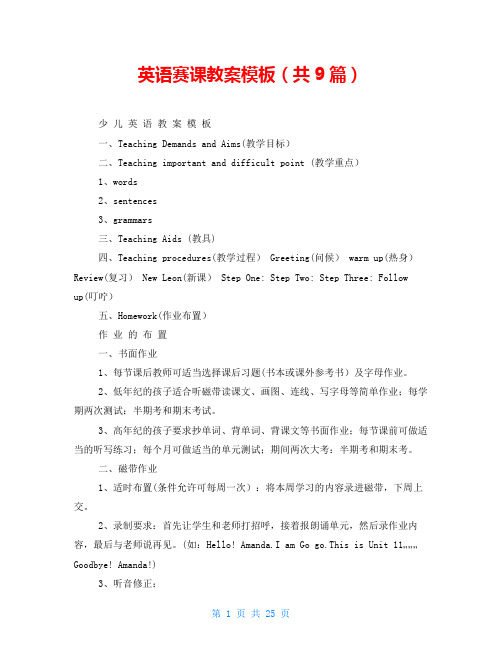
英语赛课教案模板(共9篇)少儿英语教案模板一、Teaching Demands and Aims(教学目标)二、Teaching important and difficult point (教学重点)1、words2、sentences3、grammars三、Teaching Aids (教具)四、Teaching procedures(教学过程) Greeting(问候) warm up(热身)Review(复习) New Leon(新课) Step One: Step Two: Step Three: Followup(叮咛)五、Homework(作业布置)作业的布置一、书面作业1、每节课后教师可适当选择课后习题(书本或课外参考书)及字母作业。
2、低年纪的孩子适合听磁带读课文、画图、连线、写字母等简单作业;每学期两次测试:半期考和期末考试。
3、高年纪的孩子要求抄单词、背单词、背课文等书面作业;每节课前可做适当的听写练习;每个月可做适当的单元测试;期间两次大考:半期考和期末考。
二、磁带作业1、适时布置(条件允许可每周一次):将本周学习的内容录进磁带,下周上交。
2、录制要求:首先让学生和老师打招呼,接着报朗诵单元,然后录作业内容,最后与老师说再见。
(如:Hello! Amanda.I am Go go.This is Unit 11……… Goodbye! Amanda!)3、听音修正:(1)书面记录:边听边把学生的错音登记在学生手册上。
(2)修正过程:A:打招呼,先表扬肯定,后提出错误,注意错音的跟读 B:说悄悄话,增进师生感情交流 C:提出问题。
D:结束Say:“ Good bye! ”三、电话教学1、时间安排:每月两次的电话教学,每生教学时间不超过8分钟。
2、教学内容:(1)本周学习单词及课文的朗诵。
(2)词句的翻译。
(3)疑难解答。
(4)家长的经验交流。
《云的观测》教学设计教学目标:1、能够根据云量的多少,把天气分为晴天、多云和阴天;知道云在天空中是会变化的,不同的云预示着不同天气的来临。
小学英语赛课优秀教案模板

一、教学目标1. 知识目标:学生能够正确地读、写、理解并运用所学的英语单词和句型。
2. 能力目标:提高学生的英语听说能力,培养学生的英语思维和表达能力。
3. 情感目标:激发学生学习英语的兴趣,培养学生良好的学习习惯。
二、教学内容本节课以小学英语三年级下册《Unit 3 My Family》为主题,围绕家庭成员展开教学。
三、教学重点与难点1. 教学重点:家庭成员的英语表达和介绍。
2. 教学难点:如何让学生在轻松愉快的氛围中掌握家庭成员的英语表达。
四、教学过程1. 导入(1)教师用简单的英语问候学生,激发学生学习兴趣。
(2)展示家庭图片,引导学生用英语描述图片内容。
2. 新课导入(1)教师展示家庭成员的图片,引导学生用英语介绍。
(2)播放家庭成员的英文歌曲,让学生跟唱。
3. 课堂活动(1)单词教学:教师展示家庭成员的单词卡片,让学生认读、拼写。
(2)句型教学:教师带领学生练习家庭成员的英语表达,如:This is my father. He is a teacher. He is tall and handsome.(3)角色扮演:教师组织学生进行角色扮演,让学生运用所学知识介绍自己的家庭成员。
4. 练习环节(1)完成教材中的练习题,巩固所学知识。
(2)小组合作,用英语进行家庭介绍。
5. 总结与拓展(1)教师对本节课所学内容进行总结,强调重点和难点。
(2)播放英语动画短片,让学生在观看中感受英语的魅力。
五、教学评价1. 学生课堂参与度:观察学生在课堂上的表现,评价其学习态度和积极性。
2. 学生掌握情况:通过课堂练习和课后作业,了解学生对家庭成员的英语表达和介绍的掌握程度。
3. 学生情感态度:关注学生在课堂上的情感体验,评价其学习兴趣和习惯。
六、教学反思本节课通过多种教学手段,激发学生学习英语的兴趣,提高学生的英语听说能力。
在今后的教学中,教师应继续关注学生的情感态度,培养学生的英语思维和表达能力,为学生的英语学习奠定基础。
少儿英语公开课教案lesson

少儿英语公开课教案Lesson 1-5一、Lesson 1: Greetings and IntroductionsObjective:1. Students will be able to introduce themselves and greet others in English.2. Students will learn basic phrases for asking and responding to questions about their names, ages, and favorite colors.Materials:1. Flashcards with pictures of different colors2. Name tagsProcedure:1. Begin the lesson with a warm-up activity, such as a simple song or dance to get the students engaged.2. Introduce yourself and ask the students to introduce themselves. Model the correct phrases and pronunciation.3. Distribute name tags to the students and have them wear them for the duration of the lesson.4. Display the flashcards with pictures of different colors and ask the students to identify the colors.5. Practice asking and responding to questions about names, ages, and favorite colors. Encourage the students to ask each other these questions.6. Conduct a role-play activity where the students practice introducing themselves and asking questions to their classmates.7. End the lesson with a fun game, such as "Simon Says" using color names in English.二、Lesson 2: Alphabet RecognitionObjective:1. Students will be able to recognize and name the letters of the English alphabet.2. Students will learn the correct pronunciation of each letter. Materials:1. Large alphabet letters displayed on flashcards2. Worksheet with pictures of objects that start with each letter of the alphabetProcedure:1. Begin the lesson singing the "Alphabet Song" to familiarize the students with the letters of the alphabet.2. Display the large alphabet letters on flashcards and have the students repeat the letters and their pronunciations.3. Practice tracing the letters of the alphabet on a large whiteboard or blackboard.4. Hand out the worksheets and have the students circle the objects that start with each letter of the alphabet.5. Conduct a group activity where the students take turns naming objects that start with each letter of the alphabet.6. End the lesson with a fun game, such as "Memory Match" using alphabet letters as cards.三、Lesson 3: Numbers and CountingObjective:1. Students will be able to count from 1 to 20 in English.2. Students will learn to recognize and write numbers 1-20. Materials:1. Number flashcards2. Counters or small objects to represent numbersProcedure:1. Begin the lesson introducing the concept of numbers and counting.2. Display the number flashcards and have the students repeat the numbers and their pronunciations.3. Practice counting with the students, using counters or small objects to represent the numbers.4. Hand out worksheets with number lines and have the students fill in the missing numbers.5. Conduct a group activity where the students take turns counting objects in the classroom, such as chrs or desks.6. End the lesson with a fun game, such as "Number Memory" usingnumber cards.四、Lesson 4: Simple Sentences and QuestionsObjective:1. Students will be able to construct simple sentences in English.2. Students will learn to ask and answer questions using simple sentence structure.Materials:1. Flashcards with pictures of everyday objects2. Worksheet with sentences to pleteProcedure:1. Begin the lesson introducing the concept of simple sentences and questions.2. Display the flashcards with pictures of everyday objects and have the students name the objects.3. Practice constructing simple sentences using the objects, such as "This is a book" or "She has a pen."4. Introduce question words, such as "What is this?" or "Who has a pen?" and have the students ask and answer questions using simple sentence structure.5. Hand out the worksheets and have the students plete the sentences using the pictures provided.6. Conduct a group activity where the students take turns asking andanswering questions using simple sentence structure.7. End the lesson with a fun game, such as "Charades" using simple sentences as clues.五、Lesson 5: Days of the Week and MonthsObjective:1. Students will be able to name the days of the week and months in English.2. Students will learn the correct order of the days and months. Materials:1. Flashcards with pictures of the days of the六、Lesson 6: Colors and ShapesObjective:1. Students will be able to name and recognize different colors and shapes in English.2. Students will learn to describe objects using color and shape adjectives.Materials:1. Flashcards with pictures of different colors and shapes2. Colored objects or shapesProcedure:1. Begin the lesson reviewing the colors and shapes learned in previous lessons.have the students name them.3. Practice describing objects using color and shape adjectives, such as "The circle is red" or "The square is blue."4. Hand out colored objects or shapes and have the students practice describing them.5. Conduct a group activity where the students take turns finding objects in the classroom that match the given color or shape.6. End the lesson with a fun game, such as "Color and Shape Memory" using color and shape cards.七、Lesson 7: Animal Names and SoundsObjective:1. Students will be able to name and imitate the sounds of different animals in English.2. Students will learn to associate animal names with their corresponding sounds.Materials:1. Flashcards with pictures of different animals2.玩具动物声音Procedure:1. Begin the lesson introducing the concept of animal names and sounds.students name them.3. Play the toy animal sounds and have the students guess which animal it is.4. Practice imitating the sounds of different animals and associating them with their names, such as "The dog says 'Woof!'" or "The cat says 'Meow!'"5. Hand out small toy animals and have the students practice making their sounds.6. Conduct a group activity where the students take turns bringing out a toy animal and having the others guess its name and sound.7. End the lesson with a fun game, such as "Animal Charades" using animal names and sounds as clues.八、Lesson 8: Family and FriendsObjective:1. Students will be able to name and describe their family and friends in English.2. Students will learn to use possessive pronouns and adjectives to talk about their loved ones.Materials:1. Flashcards with pictures of family members and friends2. Worksheet with sentences to pleteProcedure:1. Begin the lesson introducing the concept of family and friends.2. Display the flashcards with pictures of family members and friends and have the students name them.3. Practice using possessive pronouns and adjectives to describe their family and friends, such as "This is my mother" or "She is my best friend."4. Hand out the worksheets and have the students plete the sentences using the pictures provided.5. Conduct a group activity where the students take turns sharing information about their family and friends.6. End the lesson with a fun game, such as "Guess Who?" using pictures of students' family members and friends as clues.九、Lesson 9: Actions and VerbsObjective:1. Students will be able to name and describe different actions and activities in English.2. Students will learn to use action words (verbs) to describe what people are doing.Materials:1. Flashcards with pictures of different actions and activities2. Action figures or dollsProcedure:1. Begin the lesson introducing the concept of actions and verbs.2. Display the flashcards with pictures of different actions and activities and have the students name them.3. Practice using action words (verbs) to describe what people are doing in each picture, such as "She is running" or "He is jumping."4. Hand out action figures or dolls and have the students practice acting out the actions and using the corresponding verbs.5. Conduct a group activity where the students take turns acting out actions and having the others guess what they are doing.6. End the lesson with a fun game, such as "Action Charades" using action words as clues.十、Lesson 10: Review and AssessmentObjective:1. Students will demonstrate their understanding of the concepts and skills learned throughout the course.2. Students will improve their speaking, listening, reading, and writing skills through a variety of review activities.Materials:1. Review worksheet with a variety of activities2. Assessment tools, such重点和难点解析一、Lesson 1: Greetings and Introductions重点关注环节:1. 学生自我介绍和问候他人的正确phrases 和发音。
少儿英语优秀教案5篇

少儿英语优秀教案5篇少儿英语优秀教案1【活动目标】1、学会新英文单词“eyes”、“mouth”、“nose”和句子“I have a mouth”2、能够手指自己或他人的器官说出英文单词,发音准确,清晰,能熟练说出“I have”句型。
3、能够自信、愉快的用英文表达,乐意学习英文。
【活动准备】1、手工制作的立体画眼睛、鼻子和嘴巴若干个。
2、三个袋子。
【活动过程】1、先用热身引入话题。
进行热身活动“认识我自己”的热身(这个活动包括了全身上下的器官名称)。
2、热身活动完毕后,教师立即引入话题“小朋友们,刚才我们做的热身活动里说到了很多器官,那么小朋友们想不想用英文表达这些器官呢?想不想你呢个用英文来做这个热身呢?”引发幼儿兴趣,接着告诉幼儿今天先学习其中的几个器官,今后会慢慢学习完毕。
3、教师拿出眼睛道具,问小朋友名称。
等小朋友说出后,教师可立即示范英文发音。
教师可示意孩子一边抚摸着自己的眼睛或其他器官,一边大声学习新单词。
4、单词学习完毕后,要用游戏巩固。
请三位小朋友上台来。
教师将道具放入袋子中,请小朋友同时从袋子里取出一样物品,取出物品后迅速念出物品的单词,看谁念得又快又好,可反复换小朋友进行。
5、游戏结束。
教师请小朋友站起来,教师随机念出一个单词,小朋友就要即刻去触摸自己的相应器官,建立起孩子实物和单词的联系,巩固单词。
少儿英语优秀教案2活动设计背景我设计的这个活动是小班上学期的英语活动,对于小班年龄段的幼儿来说,英语是个新鲜事物,他们对此有着浓厚的兴趣,他们喜欢英语单词、律动、儿歌……认识新的英语单词是他们值得骄傲的事情之一。
活动目标1、培养幼儿对于英语的兴趣,让幼儿乐意参与英语活动。
2、在教师的带领下,让幼儿了解几种水果的英文名称。
3、鼓励幼儿能模仿教师说英语。
活动准备盒子和不透明小袋子一个,苹果、梨、橘子、香蕉的实物及图片各若干,一幅画有一棵大树的画,刀、碟子、餐纸,多媒体课件。
教学重点、难点重点:认读单词“apple”、“banana”、“pear”、“orange”。
少儿英语教案
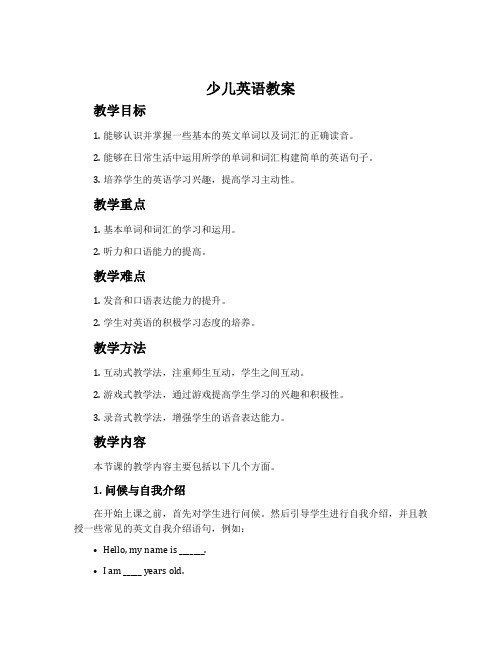
少儿英语教案教学目标1.能够认识并掌握一些基本的英文单词以及词汇的正确读音。
2.能够在日常生活中运用所学的单词和词汇构建简单的英语句子。
3.培养学生的英语学习兴趣,提高学习主动性。
教学重点1.基本单词和词汇的学习和运用。
2.听力和口语能力的提高。
教学难点1.发音和口语表达能力的提升。
2.学生对英语的积极学习态度的培养。
教学方法1.互动式教学法,注重师生互动,学生之间互动。
2.游戏式教学法,通过游戏提高学生学习的兴趣和积极性。
3.录音式教学法,增强学生的语音表达能力。
教学内容本节课的教学内容主要包括以下几个方面。
1. 问候与自我介绍在开始上课之前,首先对学生进行问候。
然后引导学生进行自我介绍,并且教授一些常见的英文自我介绍语句,例如:•Hello, my name is _______.•I am _____ years old.•Nice to meet you!2. 常见的英文动物名称针对学生的年龄特点,本节课教授常见的英文动物名称。
引导学生跟随老师发音,并且复读几次。
然后组织学生进行小组讨论,提高口语表达能力。
以下是教授的部分英文单词及其发音:•dog : /dɑɡ/•cat : /kæt/•bird : /bɜrd/•fish : /fɪʃ/•elephant : /ˈɛləfənt/•monkey : /ˈmʌŋki/•giraffe : /dʒəˈrɑːf/3. 英语歌曲通过英语歌曲的方式,让学生在轻松的氛围中学习英语单词和发音。
播放进口的英文儿歌,并让学生跟着唱。
鼓励学生自由发挥,但要保证唱的正确性。
以下是一些适合学生学唱的英文儿歌:•Twinkle, Twinkle, Little Star•Old MacDonald Had a Farm•Wheels on the Bus教学流程教学流程如下。
时间教学内容教学方法10:00-10:10 问候与自我介绍互动式教学法10:10-10:30 常见的英文动物名称互动式教学法10:30-10:45 英语歌曲录音式教学法10:45-11:00 总结与反思游戏式教学法教学评价方式1.口头表现和发音。
少儿英语教案

少儿英语教案教案一:词汇学习教学目标:帮助学生学习和掌握一些基础的英语词汇。
教学材料:单词卡片、图片、录音机、黑板、笔、课件。
教学步骤:1. 导入新词汇- 教师提前准备好词汇卡片,上面写着不同的单词。
将卡片分发给学生。
- 教师用图片或者示例句子向学生展示第一个单词,然后读出该单词的发音,并让学生跟读。
之后,教师可以提问学生这个词汇的意思,并鼓励学生回答。
2. 词汇学习- 教师将每个单词的意思和发音写在黑板上,学生可以根据需要复习。
- 继续展示词汇卡片,并让学生跟读发音。
- 教师可以通过游戏或者活动来帮助学生巩固词汇的学习,例如:根据词汇卡片进行拼图游戏,或者利用课件上的配套练习进行词汇测试。
3. 课堂练习- 学生分成小组,进行情景对话练习。
- 每个小组选择一种情景,然后利用所学的词汇进行对话练习。
教师可以提供一些问题或者提示,帮助学生展开对话。
- 教师轮流巡视每个小组的练习情况,及时给予学生指导和反馈。
4. 总结和拓展- 教师总结本节课学习的内容,回顾新学的词汇,并强调学生在日常生活中要继续巩固所学的单词。
- 教师可以鼓励学生利用课余时间使用英语学习APP或者参加英语角等活动,以提高词汇学习的效果。
- 教师可以提出一些拓展问题,引导学生运用所学的词汇进行更多的练习和思考。
教案二:口语对话练习教学目标:帮助学生提高口语交流能力,能够用简单的英语进行日常对话。
教学材料:情景卡片、录音机、黑板、笔、课件。
教学步骤:1. 导入新情景- 教师提前准备好不同的情景卡片,上面写着一个具体的日常场景。
将卡片分发给学生。
- 教师向学生展示第一个情景卡片,并让学生观察卡片上的图片,讨论这个情景可能会发生的对话内容。
2. 对话练习- 学生根据所分发的情景卡片,分成小组进行对话练习。
每个小组假设自己处于卡片上的情景,利用所学的英语进行对话练习。
- 教师可以提供一些问题或者提示,帮助学生展开对话。
- 教师轮流巡视每个小组的练习情况,及时给予学生指导和反馈。
少儿英语比赛教案模板范文
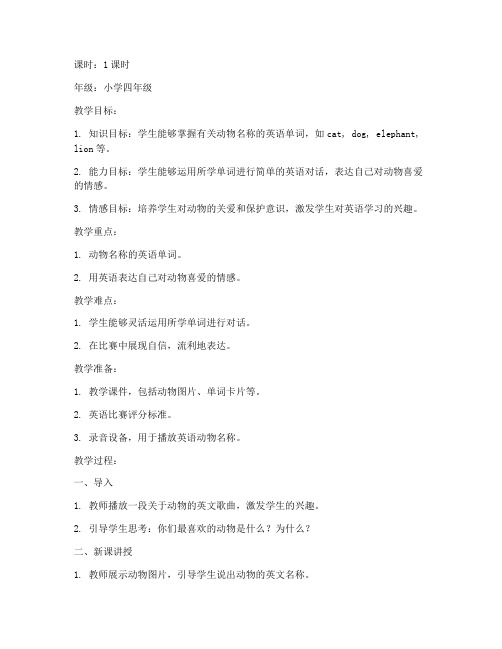
课时:1课时年级:小学四年级教学目标:1. 知识目标:学生能够掌握有关动物名称的英语单词,如cat, dog, elephant, lion等。
2. 能力目标:学生能够运用所学单词进行简单的英语对话,表达自己对动物喜爱的情感。
3. 情感目标:培养学生对动物的关爱和保护意识,激发学生对英语学习的兴趣。
教学重点:1. 动物名称的英语单词。
2. 用英语表达自己对动物喜爱的情感。
教学难点:1. 学生能够灵活运用所学单词进行对话。
2. 在比赛中展现自信,流利地表达。
教学准备:1. 教学课件,包括动物图片、单词卡片等。
2. 英语比赛评分标准。
3. 录音设备,用于播放英语动物名称。
教学过程:一、导入1. 教师播放一段关于动物的英文歌曲,激发学生的兴趣。
2. 引导学生思考:你们最喜欢的动物是什么?为什么?二、新课讲授1. 教师展示动物图片,引导学生说出动物的英文名称。
2. 将学生分成小组,每组选择一种动物,并准备相关单词卡片。
3. 教师带领学生复习动物名称,并进行简单的句子练习,如:“What's this? It's a dog.”(这是什么?它是一只狗。
)4. 学生展示自己小组准备的单词卡片,进行小组竞赛。
三、巩固练习1. 教师播放一段英语听力材料,学生根据听力内容回答问题,如:“What's the name of the animal?”(这只动物的名称是什么?)2. 学生自由组合,进行角色扮演,用所学单词进行对话。
四、比赛环节1. 学生分组进行英语比赛,每组选派一名代表进行比赛。
2. 比赛内容:用英语介绍自己最喜欢的动物,并说明原因。
3. 教师根据比赛评分标准进行评分,评选出最佳表现奖。
五、总结与反馈1. 教师对比赛进行总结,表扬优秀学生,鼓励其他学生。
2. 学生分享自己在比赛中的收获和感受。
教学反思:本节课通过动物名称的学习和比赛,激发了学生对英语学习的兴趣,培养了他们的口语表达能力。
少儿英语公开课教案lesson
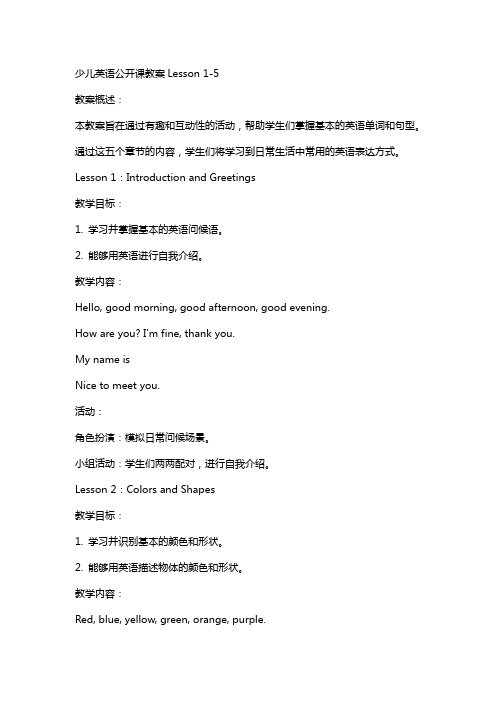
少儿英语公开课教案Lesson 1-5教案概述:本教案旨在通过有趣和互动性的活动,帮助学生们掌握基本的英语单词和句型。
通过这五个章节的内容,学生们将学习到日常生活中常用的英语表达方式。
Lesson 1:Introduction and Greetings教学目标:1. 学习并掌握基本的英语问候语。
2. 能够用英语进行自我介绍。
教学内容:Hello, good morning, good afternoon, good evening.How are you? I'm fine, thank you.My name isNice to meet you.活动:角色扮演:模拟日常问候场景。
小组活动:学生们两两配对,进行自我介绍。
Lesson 2:Colors and Shapes教学目标:1. 学习并识别基本的颜色和形状。
2. 能够用英语描述物体的颜色和形状。
教学内容:Red, blue, yellow, green, orange, purple.Circle, square, triangle, rectangle, ellipse.活动:颜色和形状的匹配游戏。
学生用英语描述桌面上的物体颜色和形状。
Lesson 3:Numbers and Counting教学目标:1. 学习并掌握基本的数字。
2. 能够用英语进行简单的计数。
教学内容:Numbers 1-10.Counting objects.活动:数字拼图游戏。
学生分组进行计数比赛。
Lesson 4:Family and Friends教学目标:1. 学习并掌握家庭成员和朋友的英语表达。
2. 能够用英语描述自己的家庭成员和朋友。
教学内容:Mother, father, sister, brother, grandmother, grandfather. Friend, friend's name.活动:家庭和朋友的图片匹配游戏。
赛课小学英语教案模板范文
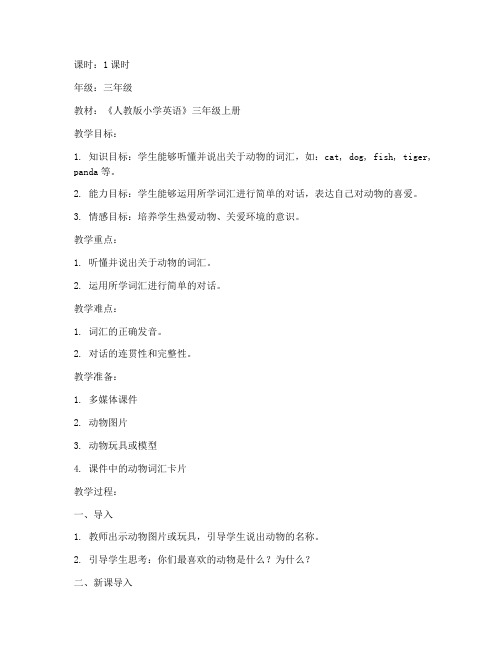
课时:1课时年级:三年级教材:《人教版小学英语》三年级上册教学目标:1. 知识目标:学生能够听懂并说出关于动物的词汇,如:cat, dog, fish, tiger, panda等。
2. 能力目标:学生能够运用所学词汇进行简单的对话,表达自己对动物的喜爱。
3. 情感目标:培养学生热爱动物、关爱环境的意识。
教学重点:1. 听懂并说出关于动物的词汇。
2. 运用所学词汇进行简单的对话。
教学难点:1. 词汇的正确发音。
2. 对话的连贯性和完整性。
教学准备:1. 多媒体课件2. 动物图片3. 动物玩具或模型4. 课件中的动物词汇卡片教学过程:一、导入1. 教师出示动物图片或玩具,引导学生说出动物的名称。
2. 引导学生思考:你们最喜欢的动物是什么?为什么?二、新课导入1. 教师通过课件展示动物图片,引导学生复习已学过的动物词汇。
2. 教师播放动物叫声,让学生猜一猜是什么动物。
三、新课学习1. 教师带领学生学习新的动物词汇,如:cat, dog, fish, tiger, panda等。
2. 学生跟读,教师纠正发音。
3. 教师出示动物词汇卡片,让学生找出对应的动物图片。
四、练习1. 教师出示一组动物图片,让学生用所学词汇进行描述。
2. 学生两人一组,互相练习对话,表达自己对动物的喜爱。
五、游戏环节1. 教师组织学生进行“猜动物”游戏,巩固所学词汇。
2. 学生根据教师的描述,猜出对应的动物。
六、总结1. 教师引导学生回顾本节课所学的动物词汇。
2. 学生分享自己最喜欢的动物,并说明原因。
七、作业布置1. 复习本节课所学的动物词汇。
2. 画一幅自己最喜欢的动物,并用英语写一段简单的介绍。
教学反思:本节课通过图片、玩具、游戏等多种形式,激发了学生的学习兴趣。
在教学过程中,教师注重学生的发音和对话能力的培养,使学生在轻松愉快的氛围中掌握了动物词汇。
同时,教师引导学生关爱动物,树立正确的环保意识。
在今后的教学中,我将继续探索更多有趣的教学方法,提高学生的学习效果。
少儿英语活动教案模板范文
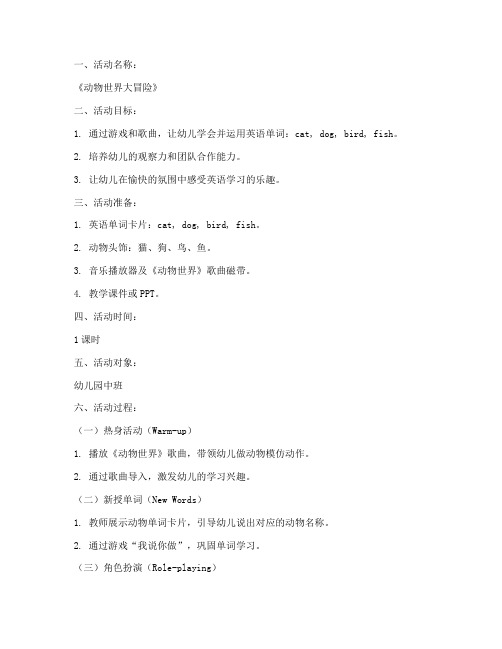
一、活动名称:《动物世界大冒险》二、活动目标:1. 通过游戏和歌曲,让幼儿学会并运用英语单词:cat, dog, bird, fish。
2. 培养幼儿的观察力和团队合作能力。
3. 让幼儿在愉快的氛围中感受英语学习的乐趣。
三、活动准备:1. 英语单词卡片:cat, dog, bird, fish。
2. 动物头饰:猫、狗、鸟、鱼。
3. 音乐播放器及《动物世界》歌曲磁带。
4. 教学课件或PPT。
四、活动时间:1课时五、活动对象:幼儿园中班六、活动过程:(一)热身活动(Warm-up)1. 播放《动物世界》歌曲,带领幼儿做动物模仿动作。
2. 通过歌曲导入,激发幼儿的学习兴趣。
(二)新授单词(New Words)1. 教师展示动物单词卡片,引导幼儿说出对应的动物名称。
2. 通过游戏“我说你做”,巩固单词学习。
(三)角色扮演(Role-playing)1. 将幼儿分成四组,每组选择一种动物角色。
2. 教师播放音乐,每组轮流进行角色扮演,展示所选动物的独特动作。
(四)小组游戏(Group Game)1. 游戏名称:“动物世界大冒险”。
2. 游戏规则:每组幼儿手持动物头饰,跟随音乐节奏,按照规定的路线进行“冒险”。
3. 遇到障碍物时,需用英语说出障碍物名称,并通过团队合作解决。
(五)总结与复习(Summary and Review)1. 教师带领幼儿回顾本节课所学单词。
2. 进行单词接龙游戏,巩固所学知识。
七、活动延伸:1. 鼓励幼儿回家后,与家人分享所学单词和游戏。
2. 家长可以协助幼儿在家中练习角色扮演,提高英语口语表达能力。
八、教学反思:1. 教师需关注幼儿在活动中的参与度,及时调整教学策略。
2. 注重培养幼儿的团队合作精神,提高他们的英语学习兴趣。
3. 通过游戏和歌曲,让幼儿在轻松愉快的氛围中学习英语。
九、板书设计:1. 动物单词:cat, dog, bird, fish。
2. 动物动作:meow, bark, tweet, swim。
少儿英语教案模板
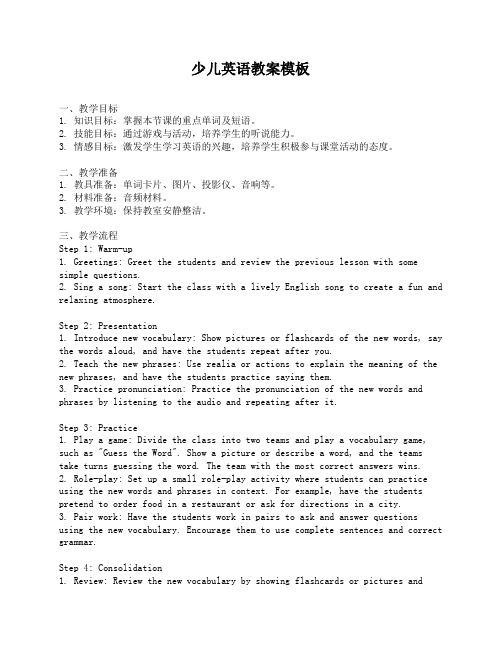
少儿英语教案模板一、教学目标1. 知识目标:掌握本节课的重点单词及短语。
2. 技能目标:通过游戏与活动,培养学生的听说能力。
3. 情感目标:激发学生学习英语的兴趣,培养学生积极参与课堂活动的态度。
二、教学准备1. 教具准备:单词卡片、图片、投影仪、音响等。
2. 材料准备:音频材料。
3. 教学环境:保持教室安静整洁。
三、教学流程Step 1: Warm-up1. Greetings: Greet the students and review the previous lesson with some simple questions.2. Sing a song: Start the class with a lively English song to create a fun and relaxing atmosphere.Step 2: Presentation1. Introduce new vocabulary: Show pictures or flashcards of the new words, say the words aloud, and have the students repeat after you.2. Teach the new phrases: Use realia or actions to explain the meaning of the new phrases, and have the students practice saying them.3. Practice pronunciation: Practice the pronunciation of the new words and phrases by listening to the audio and repeating after it.Step 3: Practice1. Play a game: Divide the class into two teams and play a vocabulary game, such as "Guess the Word". Show a picture or describe a word, and the teams take turns guessing the word. The team with the most correct answers wins.2. Role-play: Set up a small role-play activity where students can practice using the new words and phrases in context. For example, have the students pretend to order food in a restaurant or ask for directions in a city.3. Pair work: Have the students work in pairs to ask and answer questions using the new vocabulary. Encourage them to use complete sentences and correct grammar.Step 4: Consolidation1. Review: Review the new vocabulary by showing flashcards or pictures andhaving the students say the words aloud.2. Mini quiz: Give a mini quiz to assess the students' understanding of the new words and phrases. For example, show a picture and ask the students to say the word or match the word with its corresponding picture.Step 5: Wrap-up1. Recap: Summarize the key points of the lesson and ask the students if they have any questions.2. Homework: Assign homework, such as completing a worksheet or practicing the new words and phrases at home.四、教学反思本节课采用了多种教学方法,如歌曲唱跳、游戏和角色扮演等,使学生在轻松愉快的氛围中学习英语。
儿童英语大赛教案模板范文
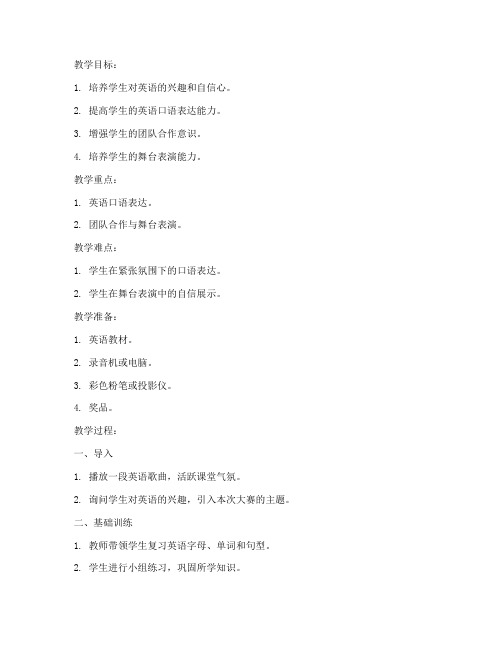
教学目标:1. 培养学生对英语的兴趣和自信心。
2. 提高学生的英语口语表达能力。
3. 增强学生的团队合作意识。
4. 培养学生的舞台表演能力。
教学重点:1. 英语口语表达。
2. 团队合作与舞台表演。
教学难点:1. 学生在紧张氛围下的口语表达。
2. 学生在舞台表演中的自信展示。
教学准备:1. 英语教材。
2. 录音机或电脑。
3. 彩色粉笔或投影仪。
4. 奖品。
教学过程:一、导入1. 播放一段英语歌曲,活跃课堂气氛。
2. 询问学生对英语的兴趣,引入本次大赛的主题。
二、基础训练1. 教师带领学生复习英语字母、单词和句型。
2. 学生进行小组练习,巩固所学知识。
三、口语表达训练1. 教师设定话题,让学生进行小组讨论。
2. 每组派代表进行口语表达,其他组进行评价。
3. 教师对学生的口语表达进行点评和指导。
四、舞台表演训练1. 教师讲解舞台表演的基本技巧,如站位、表情、动作等。
2. 学生分组进行舞台表演排练。
3. 教师对学生的舞台表演进行点评和指导。
五、团队协作训练1. 教师组织学生进行团队合作游戏,如“找朋友”、“接力赛”等。
2. 通过游戏,让学生体会团队合作的重要性。
六、模拟大赛1. 学生分组进行模拟大赛,包括自我介绍、口语表达、舞台表演等环节。
2. 教师和同学对参赛队伍进行评价和打分。
七、总结与颁奖1. 教师对本次课程进行总结,肯定学生的表现。
2. 颁发奖品,鼓励学生继续努力。
教学反思:1. 关注学生的个体差异,因材施教。
2. 营造轻松、愉快的课堂氛围,激发学生的学习兴趣。
3. 注重培养学生的口语表达和舞台表演能力,提高学生的综合素质。
4. 鼓励学生积极参与团队合作,培养团队精神。
少儿英语比赛教案模板范文
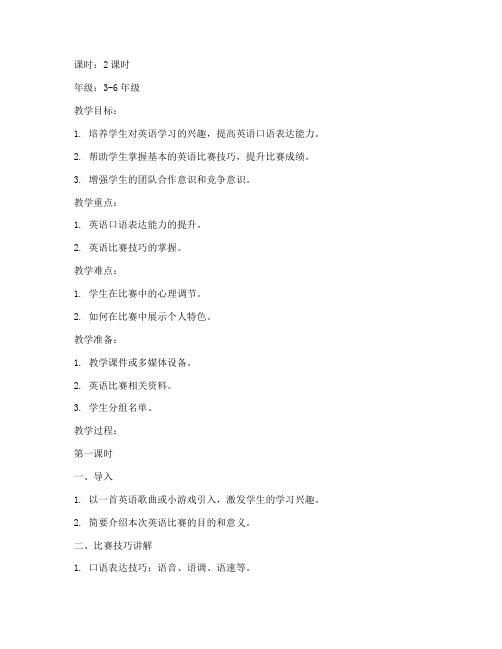
课时:2课时年级:3-6年级教学目标:1. 培养学生对英语学习的兴趣,提高英语口语表达能力。
2. 帮助学生掌握基本的英语比赛技巧,提升比赛成绩。
3. 增强学生的团队合作意识和竞争意识。
教学重点:1. 英语口语表达能力的提升。
2. 英语比赛技巧的掌握。
教学难点:1. 学生在比赛中的心理调节。
2. 如何在比赛中展示个人特色。
教学准备:1. 教学课件或多媒体设备。
2. 英语比赛相关资料。
3. 学生分组名单。
教学过程:第一课时一、导入1. 以一首英语歌曲或小游戏引入,激发学生的学习兴趣。
2. 简要介绍本次英语比赛的目的和意义。
二、比赛技巧讲解1. 口语表达技巧:语音、语调、语速等。
2. 比赛流程:自我介绍、回答问题、才艺展示等。
3. 注意事项:着装、仪态、时间控制等。
三、分组练习1. 将学生分成若干小组,每组进行比赛模拟练习。
2. 每组选派一名代表进行自我介绍和才艺展示。
3. 教师巡回指导,纠正发音、语调等问题。
四、总结与反馈1. 对学生的表现进行总结,表扬优点,指出不足。
2. 学生互相交流心得,分享比赛技巧。
第二课时一、复习上节课所学内容1. 复习口语表达技巧、比赛流程等。
2. 通过小组讨论,巩固所学知识。
二、模拟比赛1. 模拟比赛场景,让学生进行实战演练。
2. 教师扮演评委,对学生的表现进行点评。
三、团队协作训练1. 分组进行团队协作比赛,如英语演讲、英语话剧等。
2. 教师引导学生学会团队合作,发挥团队力量。
四、心理调节技巧1. 分析学生在比赛中的心理状态,如紧张、焦虑等。
2. 教授学生心理调节技巧,如深呼吸、正面思考等。
五、总结与反思1. 对学生的表现进行总结,肯定进步,指出不足。
2. 学生分享自己的比赛心得,总结经验教训。
教学评价:1. 学生在比赛中的表现:口语表达能力、比赛技巧等。
2. 学生在团队协作中的表现:沟通能力、协作精神等。
3. 学生在心理调节方面的表现:自信心、抗压能力等。
课后作业:1. 复习本节课所学内容,加强口语练习。
少儿英语公开课教案

少儿英语公开课教案一、教学目标:1. 培养孩子的英语学习兴趣,激发学生学习英语的动力。
2. 帮助学生掌握简单的英语词汇和基本的语法结构。
3. 培养学生的口语表达能力和听力理解能力。
二、教学准备:1. 绘本故事:《The Very Hungry Caterpillar》。
2. 单词卡片:水果、蔬菜、动物等相关单词。
3. 彩色图卡:用于教学展示。
4. 音乐盒或播放器:用于播放歌曲。
三、教学步骤:步骤一:导入(5分钟)1. 与学生打招呼,进行简单的英语问候。
2. 利用图片或手势引入本节课要学习的主题——水果和蔬菜。
步骤二:教学主体(15分钟)1. 展示彩色图卡,教学水果和蔬菜的英文名称。
2. 分发单词卡片,将学生分成小组,并进行单词游戏,让学生接龙说出不同的水果和蔬菜的英文名称。
3. 播放歌曲《Fruit Salad》,引导学生一起唱歌,加深对水果名称的记忆。
步骤三:绘本故事(20分钟)1. 准备《The Very Hungry Caterpillar》绘本,向学生展示绘本封面,并简要介绍故事内容。
2. 按照故事内容的顺序,向学生展示绘本中的图片,并用简单的英语词句描述图片。
3. 逐页朗读绘本,让学生跟读并观察绘本中的插图,理解故事情节。
步骤四:情景对话(15分钟)1. 根据《The Very Hungry Caterpillar》故事,设置情景对话,让学生扮演不同的角色进行问答练习。
2. 演示一段情景对话,然后让学生在小组内自由练习,鼓励学生自己编写对话内容,提高口语表达能力。
步骤五:游戏活动(10分钟)1. 利用图片或卡片,设置水果和蔬菜分辨游戏,让学生根据老师的指示将不同的水果和蔬菜分成两组。
2. 激励学生积极参与游戏并展示他们的游戏成果。
步骤六:总结和作业布置(5分钟)1. 复习本节课所学过的词汇和句子。
2. 布置作业:要求学生用英文写一篇小短文,描述自己喜欢的水果或蔬菜,并在下次课上朗读和分享。
少儿英语公开课教案lesson

少儿英语公开课教案Lesson 1-5教案概述:本教案针对少儿英语学习者,以激发学生学习兴趣和培养基本英语能力为目标。
通过五个章节的课程,让学生逐步掌握英语基础语法、词汇和日常会话技巧。
课程内容涉及自我介绍、家庭成员、动物、颜色和数字等主题。
教学目标:1. 学生能够进行简单的自我介绍。
2. 学生能够描述家庭成员和动物。
3. 学生能够表达颜色和数字。
4. 学生能够运用所学知识进行日常会话。
教学工具:1. PPT课件2. 实物模型3. 彩色卡片4. 故事书5. 互动游戏教学方法:1. 情境教学法:通过设定情境,让学生在实际环境中运用英语。
2. 互动教学法:引导学生参与课堂互动,提高口语表达能力。
3. 游戏教学法:通过趣味游戏,激发学生学习兴趣。
4. 奖励教学法:鼓励学生积极参与,给予表扬和奖励。
教学内容:Lesson 1:自我介绍教学重点:介绍自己的名字、年龄和爱好。
教学步骤:1. 老师自我介绍,并引导学生模仿。
2. 分组进行角色扮演,让学生互相介绍。
3. 学生上台表演,展示自己的介绍。
Lesson 2:家庭成员教学重点:描述家庭成员的名字和关系。
教学步骤:1. 老师展示家庭成员的图片,引导学生说出名称。
2. 学生分组讨论,描述自己的家庭成员。
3. 上台展示,并用英语描述家庭成员。
Lesson 3:动物教学重点:认识常见的动物名称和特征。
教学步骤:1. 老师展示动物图片,引导学生说出名称。
2. 学生分组讨论,描述动物的特征。
3. 角色扮演,学生扮演动物进行表演。
Lesson 4:颜色教学重点:认识并能够描述常见颜色。
教学步骤:1. 老师展示颜色卡片,引导学生说出颜色。
2. 学生分组进行颜色搭配游戏。
3. 学生上台展示自己的颜色搭配。
Lesson 5:数字教学重点:认识并能够运用数字进行简单的计算。
教学步骤:1. 老师展示数字卡片,引导学生说出数字。
2. 学生进行数字接龙游戏。
3. 学生分组进行数字计算练习。
少儿英语公开课教案lesson

少儿英语公开课教案Lesson 1-5一、Lesson 1: Greetings and IntroductionsObjective: Students will be able to introduce themselves and respond to greetings in English.Materials: Flashcards with pictures of different people, name tags Procedure:1. Begin the class with a warm-up activity. Ask students to introduce themselves in their native language and then translate it into English.2. Introduce yourself to the students and ask them to repeat after you: "Hello, my name is [name]. It's nice to meet you."3. Hand out name tags to each student and have them write their names on them.4. Practice different greetings such as "Good morning," "Good afternoon," and "Good evening." Ask students to respond accordingly.5. Play a game of charades with flashcards of different people. Students must act out the person on the flashcard without using words, and the rest of the class must guess who it is.6. Encourage students to practice introducing themselves to their peers and ask questions to get to know each other better.二、Lesson 2: ColorsObjective: Students will be able to name and recognize different colors in English.Materials: Flashcards with colors, color wheel, crayons and paper Procedure:1. Begin the class asking students to name the colors of the objects in the classroom.2. Introduce the color wheel and go through each color, saying the English word and asking students to repeat after you.3. Hand out flashcards with colors on them and have students match the flashcard to the correct color on the color wheel.4. Give each student a piece of paper and crayons, and ask them to drawa picture using the colors they have learned.5. Encourage students to practice naming colors in English and ask them to find objects in the classroom that match the colors on their flashcards.三、Lesson 3: Numbers 1-10Objective: Students will be able to count from 1 to 10 in English. Materials: Number flashcards, objects to count (e.g., buttons, coins) Procedure:1. Begin the class asking students to count in their native language.2. Introduce the numbers 1-10 in English and have students repeat after you.3. Hand out number flashcards and have students match the number to the correct number of objects.4. Practice counting objects in the classroom, such as buttons, coins, orchrs.5. Play a game of "Simon Says" where the teacher says a number, and students must touch that number of objects.6. Encourage students to practice counting in English and ask them to find objects in the classroom to count.四、Lesson 4: AlphabetObjective: Students will be able to recognize and name the letters of the English alphabet.Materials: Alphabet flashcards, alphabet chartProcedure:1. Begin the class singing the "Alphabet Song" to familiarize students with the letters of the alphabet.2. Introduce each letter of the alphabet using flashcards and have students repeat after you.3. Hang an alphabet chart on the wall and point to each letter, asking students to name it.4. Practice tracing the letters of the alphabet with your finger or a pointer, and have students follow along.5. Play a game of "Memory" with alphabet flashcards. Place the flashcards face down on the table, and students must flip over two cards at a time to find matching letters.6. Encourage students to practice naming the letters of the alphabet inEnglish and ask them to find objects in the classroom that start with each letter.五、Lesson 5: Simple SentencesObjective: Students will be able to construct and understand simple sentences in English.Materials: Flashcards with pictures, sentence stripsProcedure:1. Begin the class asking students to form simple sentences in their native language.2. Introduce the concept of simple sentences in English, explning that a simple sentence consists of a subject, verb, and object.3. Hand out flashcards with pictures on them and have students create a simple sentence using the words "I," "like," and "ice cream."4. Practice using different subjects and verbs to create simple sentences, such as "She," "likes," and "dancing."5. Give each student a sentence strip with a simple sentence on it, and ask them to find the subject,六、Lesson 6: Family and FriendsObjective: Students will be able to name family members and friends in English.Materials: Flashcards with family and friend pictures, family tree diagram Procedure:1. Begin the class asking students to name their family members and friends in their native language.2. Introduce the names of family members and friends in English, such as mother, father, sister, brother, friend, etc.3. Hand out flashcards with family and friend pictures on them and have students match the flashcard to the correct name.4. Create a family tree diagram on the board or a large sheet of paper, and ask students to identify and label their family members and friends.5. Practice asking and answering questions about family and friends, such as "Do you have a brother?" or "What is your mother's name?"6. Encourage students to practice naming family members and friends in English and ask them to share information about their family and friends with their peers.七、Lesson 7: AnimalsObjective: Students will be able to name and describe different animals in English.Materials: Flashcards with animal pictures, animal sounds chart Procedure:1. Begin the class asking students to name animals in their native language.2. Introduce the names of different animals in English, showing them the flashcards with animal pictures on them.3. Practice making the sounds that each animal makes, and have students imitate the sounds.4. Hand out an animal sounds chart and ask students to circle the animal sounds they hear.5. Play a game of charades with animal flashcards. Students must act out the animal without using words, and the rest of the class must guess which animal it is.6. Encourage students to practice naming and describing animals in English and ask them to find pictures of their favorite animals to bring to class.八、Lesson 8: Food and DrinkObjective: Students will be able to name and describe different foods and drinks in English.Materials: Flashcards with food and drink pictures, food and drink menu Procedure:1. Begin the class asking students to name foods and drinks in their native language.2. Introduce the names of different foods and drinks in English, showing them the flashcards with food and drink pictures on them.3. Practice ordering food and drinks in English, using phrases such as "I would like," "please," and "thank you."4. Hand out a food and drink menu and ask students to circle the itemsthey would like to order.5. Play a game of "Memory" with food and drink flashcards. Place the flashcards face down on the table, and students must flip over two cards at a time to find matching items.6. Encourage students to practice naming and describing foods and drinks in English and ask them to bring a picture of their favorite food or drink to class.九、Lesson 9: ClothingObjective: Students will be able to name and describe different articles of clothing in English.Materials: Flashcards with clothing pictures, clothing sorting activity Procedure:1. Begin the class asking students to name articles of clothing in their native language.2. Introduce the names of different articles of clothing in English, showing them the flashcards with clothing pictures on them.3. Hand out a clothing sorting activity where students must match the clothing items to the correct category (e.g., tops, bottoms, shoes, accessories).4. Practice asking and answering questions about clothing, such as "What is your favorite color of shirt?" or "Do you like to wear jeans or shorts?"5. Play a game of charades with clothing flashcards. Students must act out the article of clothing without using words, and the rest of the class must guess which item it is.6. Encourage students to practice naming and describing articles of clothing in English and ask them to bring a picture of their favorite outfit to class.十、Lesson 10: Review and AssessmentObjective: Students will demonstrate their understanding of the concepts covered in the past ten lessons.Materials: Review worksheets, flashcards, assessment checklist Procedure:1. Begin the class reviewing the concepts covered in the past ten lessons, such as greetings, colors, numbers, alphabet, family and friends, animals, food and drink, clothing, and simple sentences.2. Hand out review worksheets where students must plete tasks related to the concepts learned, such as fill in the blank, matching, or crossword puzzles.3. Conduct a mini-ass十一、Lesson 11: Days of the WeekObjective: Students will be able to name and recognize the days of the week in English.Materials: Days of the week flashcards, calendarProcedure:1. Begin the class asking students to name the days of the week in their native language.2. Introduce the days of the week in English, showing them the flashcards with the days of the week on them.3. Hand out a calendar and ask students to circle the current day of the week.4. Practice reciting the days of the week in English, and have students repeat after you.5. Play a game of "Simon Says" where the teacher says a day of the week, and students must touch that day on the calendar.6. Encourage students to practice naming the days of the week in English and ask them to find objects in the classroom that represent each day. 十二、Lesson 12: Months and SeasonsObjective: Students will be able to name and recognize the months and seasons in English.Materials: Months and seasons flashcards, seasonal pictures Procedure:1. Begin the class asking students to name the months and seasons in their native language.2. Introduce the months and seasons in English, showing them the flashcards with the months and seasons on them.3. Hand out a calendar and ask students to circle the current month and season.4. Practice reciting the months and seasons in English, and have students repeat after you.5. Display seasonal pictures around the classroom, and ask students to identify the season each picture represents.6. Encourage students to practice naming the months and seasons in English and ask them to discuss their favorite season and why.十三、Lesson 13: TimeObjective: Students will be able to tell the time in English using simple phrases.Materials: Clock diagram, digital clock, time phrases flashcards Procedure:1. Begin the class asking students to tell the time in their native language.2. Introduce the concept of time in English, explning that telling time involves hours and minutes.3. Hand out a clock diagram and ask students to identify the current time.4. Practice using simple time phrases in English, such as "It's 3 o'clock" or "It's 2:30."5. Display a digital clock in the classroom, and ask students to practicetelling the time aloud.6. Encourage students to practice telling the time in English and ask them to set a timer for a short duration, such as 5 minutes.十四、Lesson 14: Countries and ContinentsObjective: Students will be able to name and recognize different countries and continents in English.Materials: Maps of the world, flashcards with country and continent namesProcedure:1. Begin the class asking students to name some countries and continents in their native language.2. Introduce the names of different countries and continents in English, showing them the flashcards with country and continent names on them.3. Hand out maps of the world and ask students to locate and circle the countries and continents they have learned.4. Practice naming countries and continents in English, and have students repeat after you.5. Display a world map in the classroom, and ask students to point to the countries and continents they have learned.6. Encourage students to practice naming countries and continents in English and ask them to share something interesting about a country or continent they have learned.十五、Lesson 15: Review and AssessmentObjective: Students will demonstrate their understanding of the concepts covered in the past fifteen lessons.Materials: Review worksheets, flashcards, assessment checklist Procedure:1. Begin the class reviewing the concepts covered in the past fifteen lessons, such as greetings, colors, numbers, alphabet, family and friends, animals, food and drink, clothing, days of the week, months and seasons, time, countries and continents, and simple sentences.2. Hand out review worksheets where students must plete tasks related to the concepts learned, such as fill in the blank, matching, or crossword puzzles.3. Conduct a mini-assessment to evaluate students' understanding of the concepts covered. This can be done through a written or oral assessment, depending on the students' level.4. Provide feedback and encouragement to students based on their performance, and identify areas that need further practice.5. Plan additional activities or lessons to address any areas of weakness identified during the assessment.6. Celebrate the重点和难点解析一、Lesson 1: Greetings and Introductions重点:学习如何用英语进行问候和介绍。
少儿英语公开课教案课程

少儿英语公开课教案课程一、教学内容本节课选自人教版《PEP英语》第三单元B部分,内容为故事阅读和单词学习。
故事主题是关于一个叫Lily的小女孩和她的朋友们去公园玩耍,他们在公园里看到了许多动物,并学习了动物的英文名称。
单词包括cat, dog, bird, fish等。
二、教学目标1. 学生能够听懂、会说、会读本节课的单词和句子。
2. 学生能够通过故事理解动物的特点和关系,培养学生的阅读理解能力。
3. 学生能够在实际情景中运用所学知识进行交流,提高学生的实际运用能力。
三、教学难点与重点重点:单词cat, dog, bird, fish和句型的学习。
难点:学生能够正确发音单词和句子,并在实际情景中运用。
四、教具与学具准备教具:PPT、图片、卡片、录音机等。
学具:课本、练习本、彩笔等。
五、教学过程1. 热身(5分钟)教师与学生用英语进行简单的问候,然后带领学生唱一首英文歌曲《Old MacDonald Had a Farm》,激发学生的学习兴趣。
2. 引入(10分钟)教师向学生介绍本节课的主题,展示图片和卡片,引导学生说出动物的名称,为新课的学习做好铺垫。
3. 新课学习(15分钟)教师播放故事录音,让学生边听边跟读,然后讲解故事内容,让学生理解故事情节。
接着,教师带领学生学习单词cat, dog, bird, fish,教会学生正确的发音和书写。
4. 课堂练习(10分钟)教师设计一些练习题,让学生运用所学知识进行回答。
例如,教师出示一张图片,学生要说出图片中动物的英文名称。
5. 情景剧(10分钟)教师将学生分成小组,每组学生根据所学内容,编写一个关于动物的小剧本,并进行表演。
这样既提高了学生的学习兴趣,又培养了学生的团队合作能力。
教师对本节课的内容进行简要回顾,强调单词和句型的正确发音和运用。
六、板书设计教师在黑板上板书本节课的重点单词和句型,并配上图片,方便学生理解和记忆。
七、作业设计1. 抄写本节课的单词cat, dog, bird, fish,每个单词写5遍。
少儿英语精品课大赛教案--The Ugly Duckling--Unit 6

Review
Game: Gestures and sentences
1.Role play.
Children, let’s review what we learn before.Angela will see whothe best performer is.Who wants to be…
设计意图:通过模仿表演,增加趣味性,同时练习重点句型
T:Now you are the hen. Let’s see whois the proudest.
3)班-组-个人输出请表演得好的小朋友上来为组加分
3.No, I can’t.
T: Can the ugly duckling lay an egg?
Practice
1. A cat and a hen.
T: What animals are at the farm?
S: A...
播放原声,模仿语音语调,分组PK。
Find my little tail
设计意图:通过原声输入练习发音
2. Can you lay an egg?
T: Look at the hen. Is he pround?
S: No.
T: How does he answer?
1)播放音频1次,听音频模仿,老师在旁做动作
T: Now, I am the hen. You are the ugly duckling. I will see who is the best performer.
And you can come up here to role play.
PRT精品课大赛教案
- 1、下载文档前请自行甄别文档内容的完整性,平台不提供额外的编辑、内容补充、找答案等附加服务。
- 2、"仅部分预览"的文档,不可在线预览部分如存在完整性等问题,可反馈申请退款(可完整预览的文档不适用该条件!)。
- 3、如文档侵犯您的权益,请联系客服反馈,我们会尽快为您处理(人工客服工作时间:9:00-18:30)。
T: fashionable这个单词有几个音节?
T:比较级为morefashionable。句型是A is morefashionablethan B。最高级为the most fashionable。
William wants to play basketball this weekend, because he thinks it’s ___________________ sport in the world.
a.the most amazing
b.most amazing
S1:A
3min
T-Ss
T:I likefootball, because it’s the mostpopular
sport in the world.“Popular”means thatMany peoplelikeandenjoy it.
T: popular这个单词有几个音节?
T:比较级为more popular。句型是A is morepopularthan B。比如说Lady Gaga is more popularthanme。最高级为the most popular。
Look at thepictureand say.
While-speaking
2mins
T-Ss
Activity 1: Introducethree kinds ofsports.
L, W
T:You’re going to describe the picture
T: When you see the picture, pleaseput upyourhand, andsay bingo. Then you can stand up anddescribe.
Possible
Solutions
Teacher creates more opportunities to makeSsto sum up the usages of adverb.
Personal Aims
Reduce TTT; Make a student-centeredclass
Lesson
Ss:三个音节。
15mins
S-s
Activity 2: Interview Game (Try to find out what your classmates' favorite sport is)
L, W
T: Try to find out yourclassmates'favorite sport by asking them 2 questions in 3 minutes?
T:三个或三个以上音节的形容词比较级为more amazing。句型是A is more amazing than B。比如说Basketball is more amazing than morning exercises。最高级为the most amazing。
L, S
Ss:三个音节。
T:我们来做一道练习题,并告诉我答案。
L, S
Ss: Talk first.
2) How many students do you have to interview?
SS: 3.
S-ss
T: Now, time's up. Let's share our information.
S1: XXX’s favorite sport is footballbecause it’s…in the world.
ICQ: 1)Areyou going to talk or write?
2)How many minutes do you havebefore you speak out your speech?
INS: 1)You'll have to ask questions first.
2) Write down the information on the handout.
3) You'll have to interview 3 students in 3mins.
ICQ: 1) Are you going to talk or write first?
Secondary:
Enable Ss tocompare adjective with adverb.
Materials
PPT;Marker; Handouts
Anticipated
Problems
Ss may have difficulties indefiningadverb.
Ss may feel shy toexpress their opinions.
Organization
Teacher Activities/Language
Activities
L/S/R/W
Student Activities and language(function/form)
Pre-speaking
1min
T-Ss
Lead-in:review adjectives
L, S
Ss:三个音节。
T:我们再来做一道练习题,并告诉我答案。
Lady Gaga is _____________ than William!
a.more popular
b.the most popular
S1:A
3min
T-Ss
T:I liketennis, because it’s the mostfashionable
T: What’s XXX’s favorite sport?And why does she / he like it best.
S2: XXX’s favorite sport is basketballbecause it’s…in the world.
Stage of Lesson
TEACHER PARTICIPATION
STUDENT PARTICIPATION
Time
Organization
Teacher Activities/Language
Activities
L/S/R/W
Student Activities and language(function/form)
Post-speaking
1min
Way to transfer:giving a speech
4mins
S-Ss
T:I will make a sample first.(Give Ss a sample speech.)
T:Now, the stage is yours. Weare eager to hearyour voice.
L, S, W
Ss:Talk.
Ss:2mins
INS: Prepare foryour speech in 2mins.
L, S
T-ss
T:Different students havedifferent opinions.Let’s speak out your own opinions.We want to hear your voice.
T:So let’smake a great speech.
S:Wonderful.
T: Are you going toput up your hand? Are you going tosay bingo? (ICQ)
Ok. Look and say.
SБайду номын сангаас: Yes.
S1:The turtle is slow.
S2:The bird is quick.
3mins
T-Ss
T:Ilike the three kinds of sports very much.Why doIlike them?
Aims
Listen
/
Read
PPT
Write
handouts
Memorize
How to use adverb
Record
/
Notice
/
Feedback on
Lesson Plan
Stage of Lesson
TEACHER PARTICIPATION
STUDENT PARTICIPATION
Time
Lesson Plan
Date
Day
Course
Type of Class
SpeakingClass
Lesson
Aims
Primary:
EnableSs touseadverbs to tell how something happens or how somebody does something.
T:I like basketball, because it’s the most amazing
sport in the world.“Amazing”means that it cangive you happinessandsurprise.
T: amazing这个单词有几个音节?a–ma–zing.
